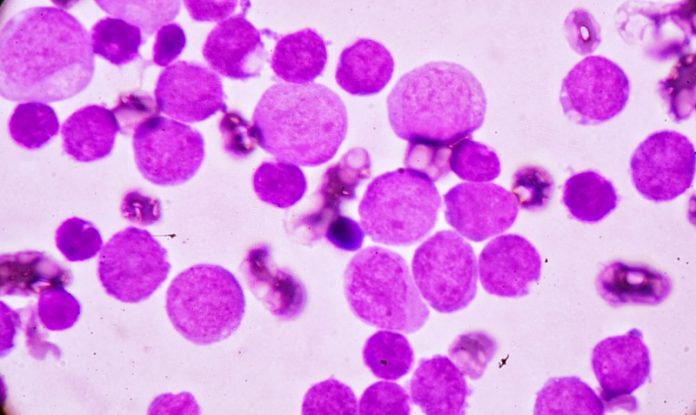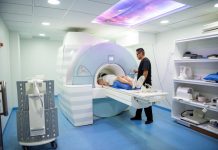Bethany Torr, Campaigns and Advocacy Officer at Leukaemia Care explores the challenges of living with acute myeloid leukaemia (AML)
September 2018 was Blood Cancer Awareness Month and Leukaemia Care launched findings from their second leukaemia patient experienc survey. Living with Leukaemia reveals and quantifies the issues experienced by leukaemia patients from diagnosis through to living with or beyond blood cancer. The survey conducted between September and December 2017, received 2329 responses from leukaemia patients, 443 of which were from acute myeloid leukaemia (AML) patients.
AML is a quickly progressing (acute) type of blood cancer. There are around 3000 people diagnosed in the UK each year. Two-thirds of patients (66%) are over the age of 65 years old at diagnosis, but it is a cancer that affects people of all ages, including children. Survival of AML is significantly age-dependent with children responding very well to treatment, but overall five-year survival rates are incredibly poor. In England, five-year survival for men is 14% and 16% in women. Unfortunately, while understanding of AML subtypes has improved over time there has been little progress in treatment over the past few decades, with intensive chemotherapy remaining the first line of treatment. This is something which many patients are not fit enough to tolerate.
The Leukaemia Care survey revealed that two in three patients were not offered a choice of treatment options at diagnosis. This may be due to both the lack of treatment options and the necessity to begin treatment quickly. Over half of patients (55%) start treatment within a week of receiving their diagnosis, with 20% starting on the same day. Many AML patients are, however, offered the choice to join a clinical trial (62%). This is more likely to happen if patients have relapsed following initial treatment because there are limited options for these patients beyond a stem cell transplant and survival is very poor.
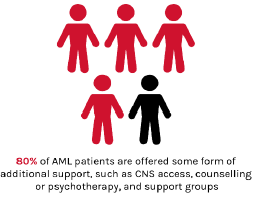
Patients report significant side effects of treatment, with 41% stating the side effects had a large impact and just 14% stating that they were barely noticeable. The most commonly experienced side effects are: fatigue (70%); constipation or diarrhoea (43%); infections (41%); muscle, bone or joint pain (37%); neutropenia (34%); nausea or vomiting (34%); and itchy skin/rashes (34%).
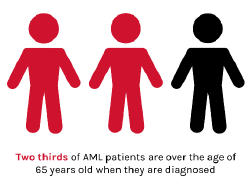
The impact of an AML diagnosis, however, goes much further beyond survival statistics and treatment sideeffects. The quality of life for a patient and their family is significantly affected by the diagnosis in terms of emotional, practical and financial implications.
Leukaemia affects people of all age groups, not just the elderly and children and 63% of patients were in work or education at the time of diagnosis. Of these people, the majority (79%) are forced to stop work/education following diagnosis. While this is temporary for many people during treatment, over one in three patients (38%) are forced to permanently stop, demonstrating the long-term implications of a diagnosis.
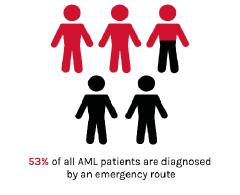
This ultimately has implications for financial circumstances with 56% of AML patients stating that their diagnosis had a negative impact on their finances, due to increased costs or reduced income. The cost of AML, for those who state a negative impact, is on average over £600 each month.
From the shock of receiving a diagnosis to going through treatment and facing the practical and financial implications, it is no surprise that patients face a significant emotional burden during this time. Two in five patients (42%) report feeling more depressed or anxious following diagnosis and 5% stated feeling constantly depressed or anxious. Fortunately, 80% of patients are offered some form of additional support, such as clinical nurse specialist access, counselling or psychotherapy and support groups.
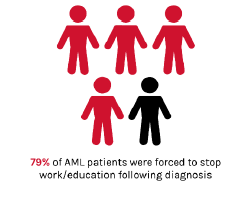
Leukaemia Care is using the Living with Leukaemia survey findings to guide both the work they are doing to support patients and their campaigns to improve outcomes and the quality of life. This includes the Blood Cancer Awareness Month campaign, Spot Leukaemia. Currently, 53% of all AML patients are diagnosed by an emergency route, which significantly impacts both one and 12-month survival. Spot Leukaemia aims to improve
early diagnosis of leukaemia by improving public understanding, raising awareness of the signs and symptoms and supporting GPs to better recognise and diagnose blood cancers. Early diagnosis saves lives.
Find out more about Leukaemia Care’s Living with Leukaemia report and Spot Leukaemia campaign by visiting: www.leukaemiacare.org.uk/get-involved/our-campaigns/
Bethany Torr
Campaigns and Advocacy Officer
Leukaemia Care
Tel: +44 (0)1905 755 977
Bethany.Torr@leukaemiacare.org.uk
www.leukaemiacare.org.uk
www.twitter.com/LeukaemiaCareUK

